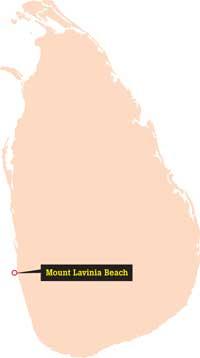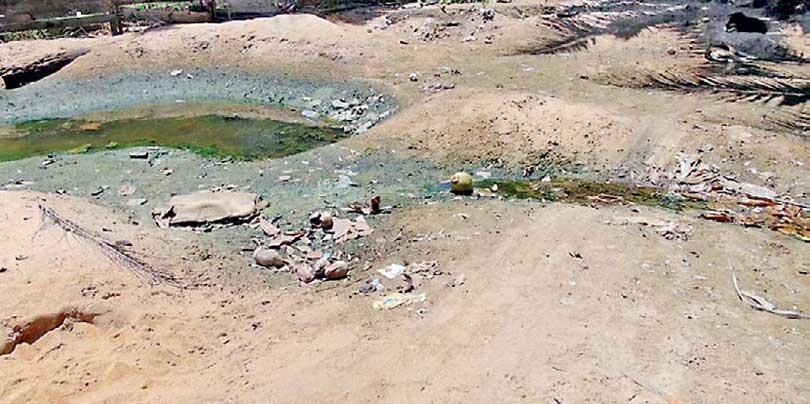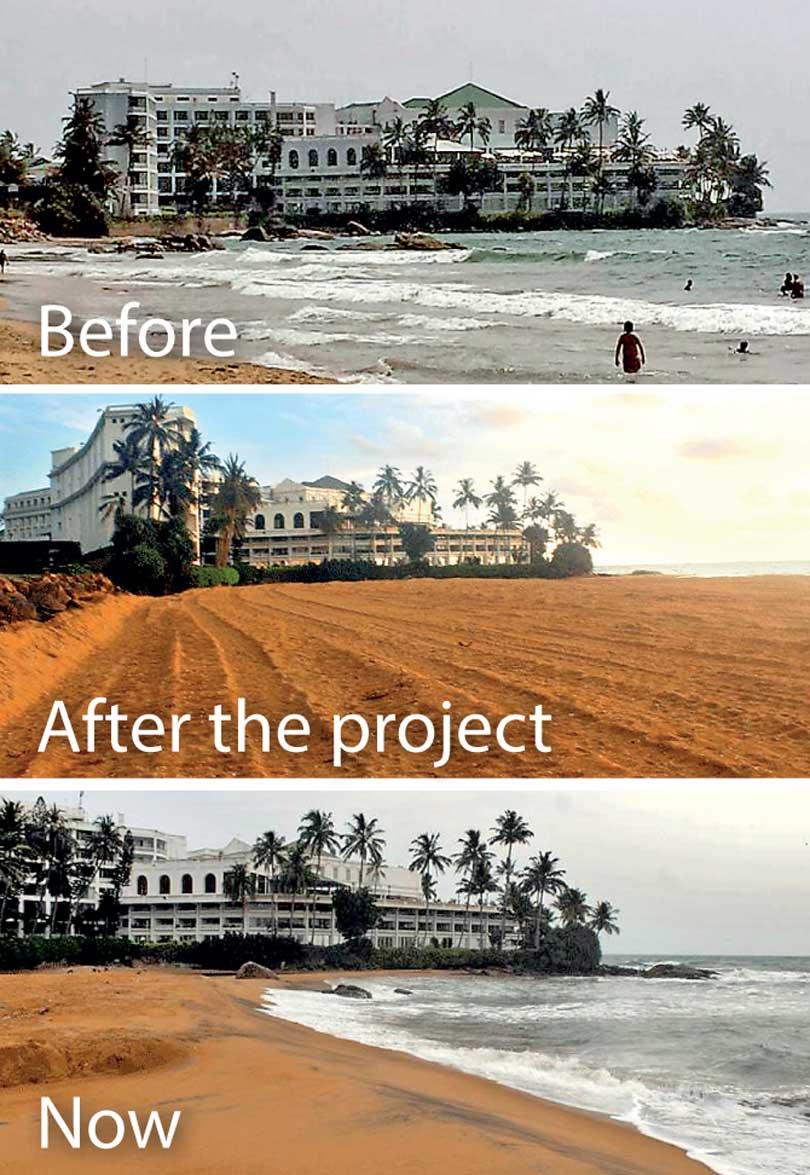01 Jun 2020 - {{hitsCtrl.values.hits}}
CCD says Artificial beach not washed away but creating natural beach according to new technique

Pic courtesy: Pearl Protectors
 By Kamanthi Wickramasinghe
By Kamanthi Wickramasinghe
The recently ‘nourished’ Mt. Lavinia Beach seems to have further eroded according to recent photos that have been circulating on social media.
The said stretch of beach was included in a Rs.890 million worth beach nourishment project and operations commenced at the onset of the curfew. Although the proposal was submitted in 2018, it was approved by the incumbent cabinet. The Calido beach in Kalutara and Ratmalana/Angulana beaches too were included in the project.
However, the recent turn of events has raised doubts among conservationists who have continuously questioned the Coast Conservation Department for not following due process.
According to the Coast Conservation and Coastal Resources Management Act No. 57 of 1981, developmental work in the coastal zone except planting and others need written approval from the Director-General of Coast Conservation Department. It further states that the DG may request an Environment Impact Assessment under his discretion but discretion should be exercised with an adequate assessment. Apart from that, an EIA should be open for public comments for 30 days.
EIA not a must for coastal development
However, in response to allegations made regarding the omission of an EIA, CCD Director-General Prabath Chandrakeerthi said that the Department had the authority to conduct developmental work in places where they observe heavy coastal erosion.
“There’s no legal barrier for us to carry out the work. But we have conducted an EIA at the place where the sand was dredged near the Ratmalana Station in 2014. Then it was renewed in 2018 and the Central Environment Authority had issued approval which is valid for three years. We have approval from the Geological Surveys and Mines Bureau as well.”
When asked why the newly added sand seems to be eroding unusually, Chandrakeerthi explained about the sand engine method. According to him, it is one way of protecting the coast. “The objective is to have a beach area filled near Wellawatte. Since sediment transport happens northwards in Sri Lanka, the sand filled at Mt. Lavinia beach will eventually end-up near Wellawatte where a new beach will be formed. Therefore the sand is being transported as per the project design. We have said that the rocks that were seen near Mt. Beach will appear after some time.”
He said that the total cost for the project was Rs. 890 million.
“The cost of transporting sand from Ratmalana to Kalutara was high because Calido Beach had to be filled with 300,000 cubic metres of sand. The Ratmalana and Angulana area required 350,000 cubic metres and 150,000 cubic metres for Mt. Lavinia beach.”
Powers manipulated
“A Cabinet decision is not above an EIA and this project is a waste of public funds,” claimed Hemantha Withanage, Executive Director at Centre for Environmental Justice.
“There was no new EIA done for the project. They are continuing work based on an EIA done in 2014 for which they have gotten an extension in 2017. The area that comes under the purview of CCD is between 300 metres from high tide level towards the land and 2 km from low tide level towards the sea. Any activity that happens beyond this area comes under the purview of the CEA. When the Coast Conservation Act was drafted in 1981 it was the first to introduce an EIA. Then in 1993, an EIA was open for public hearing under the National Environment Act.”
Speaking on the environmental impacts of the project, Withanage said that this project would have a drastic impact on the coral reef.
“I have been told that there’s a deeper area between the Paragala and Demadagala reefs. If the coral starts to slip, it will pose a threat to humans as well. The Ratmalana reef is very productive but people tried to cut it to allow boats to reach the shore. If the reef is damaged and in the event of another tsunami, the currents will reach 15-20 km towards the interior,” he warned.
Unusual soil erosion
“A long term beach nourishment project is supposed to last 8-10 years,” opined Muditha Katuwawala, coordinator for The Pearl Protectors, an environmental conservation organisation.
“This project failed since it didn’t have a proper plan. There was no EIA done and the DG has been vague in his explanations from the beginning. It is mandatory to do an EIA and open it for a public hearing for 30 days.
“We now see an unnatural erosion taking place. The sand was dredged from the deep sea and it’s still wet. Marine life that have been living in this sand is slowly dying. Without conducting an EIA we wouldn’t know the long term impacts of this project either.”
He said that the reef was now getting filled up. “During the past couple of days a deep tunnel was dug up. Since the land is at a higher elevation in this area the water that comes from the land now gets accumulated in this tunnel and a swamp has been formed. Because of this project, this area will be further eroded than how it used to be.”

A swamp being formed

10 Jan 2025 25 minute ago
10 Jan 2025 2 hours ago
10 Jan 2025 2 hours ago
10 Jan 2025 2 hours ago
10 Jan 2025 4 hours ago